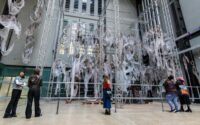The Unearthed Remains of 19th Century London Workhouse Suggest A Different Reality Than Depicted by Charles Dickens
The remains of the St Pancras workhouse in London, similar to those detailed in the writing of Charles Dickens, has been discovered by archaeologists. Unlike Dickens’ novels, however, the workhouse maintained colorful walls and fireplaces.
Archaeologists found a significant portion of the original buildings that revealed new details about the masters and residents who lived there. In particular, Gwilym Williams, a project manager at the Museum of London Archaeology (Mola), told the Guardian Wednesday that the findings painted “a very different picture compared with the dark, dingy workhouses often depicted in popular culture.”
Unlike the writing of Charles Dickens, for example, archaeologists found brightly-colored plaster and fireplaces with walls measuring roughly three feet tall. Prior to these findings, little was known about the building, with the exception of its overall shape outlined on parish maps.
In the early 19th century, workhouses were created to help the poor. In exchange for hard labor such as picking oakum fibers and breaking stones, inmates received basic food and housing. Those depicted in written record were often described as bug-infested and overcrowded.
St Pancras, which opened in 1809, appears to have been initially more focused on providing support for those experiencing difficult times. Despite its intentions, however, the building intended to house 500 increased to 1,900 inmates by the 1850s.
“While the facilities are spartan, the inmates were not there to be punished,” Williams told the Guardian. “There were gardens, an infirmary and nursery. These acknowledge their needs as much as the heated rooms, or the pale blue paint on the walls.”
The team also found institutional tableware and the remains of a bone toothbrush with horsehair bristles.
Though it’s still debated, some believe that the St Pancras facilities may be those featured in Dickens’ 1838 novel Oliver Twist. It has been confirmed that, at the very least, his friend and contributor Henry Morley wrote about the St Pancras workhouse.
In 1929, the workhouse was converted into a hospital, which was partially bombed in World War II and subsequently demolished.
The excavated areas have been unearthed ahead of the construction of Oriel, a new facility for eye care, research, and education, as a combined initiative between Moorfields Eye Hospital NHS Foundation Trust, UCL Institute of Ophthalmology, and Moorfields Eye Charity.



